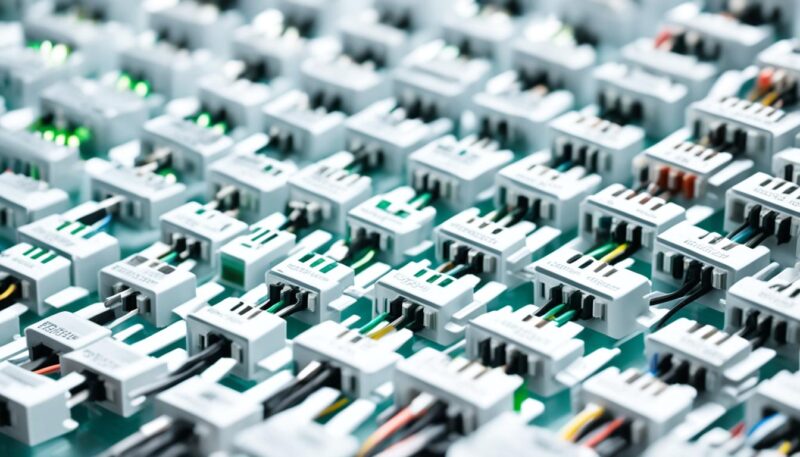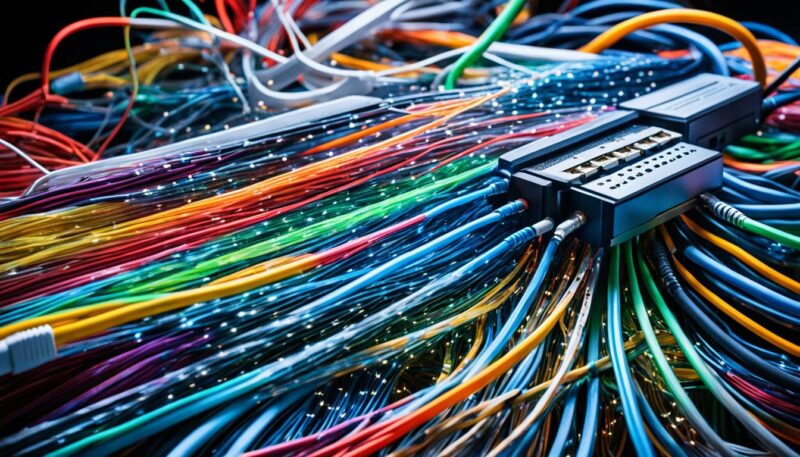Imagine streaming your favorite shows without buffering, uploading massive files in seconds, or experiencing seamless video calls with loved ones across the globe. Fiber optic internet makes this a reality, yet the initial setup can feel overwhelming, especially for beginners. But don’t worry—you’ve got this. With the right fiber optic internet equipment and a clear understanding of how it all fits together, you’re just a few steps away from an uncompromising, high-speed internet experience.
Let’s embark on this journey together, starting with a basic checklist to set up your ultimate home network setup. Equipped with the knowledge of what each component does, you’ll be well-prepared to dive into the world of fiber optics and unlock the full potential of high-speed internet equipment.
Key Takeaways
- Essential components are crucial for a successful fiber optic internet installation.
- Understanding equipment like the Optical Network Terminal (ONT), modems, and routers is key.
- Each piece of equipment plays a critical role in a high-speed home network setup.
- Choosing the right fiber optic cables ensures efficient data transmission.
- A well-thought-out setup enhances overall internet speed and connectivity.
Understanding Fiber Optic Internet: Essential Components
Fiber optic internet is revolutionizing the way we connect to the web, offering unparalleled speed and reliability. To capitalize on this cutting-edge technology, it is crucial to understand the essential components involved in a fiber optic internet setup.
Optical Network Terminal (ONT)
The Optical Network Terminal, or ONT, is a critical device in any fiber optic internet setup. The ONT setup converts the light signals received through fiber optic cables into electrical signals that can be used by household devices. This ensures that the data transmitted through the fiber optic network is accessible to users.
Fiber Optic Modem
A fiber optic modem works hand-in-hand with the ONT. Its primary responsibility is to manage the conversion from optical to electrical signals, thereby facilitating a seamless internet connection. This modem is specifically optimized to handle the unique characteristics of fiber connectivity, ensuring minimal latency and high data throughput.
Fiber Router
Once the data has been converted, it is channeled through a fiber router. This device is engineered to handle the high bandwidth provided by fiber optic technology, ensuring that multiple devices can connect to the internet simultaneously without experiencing any slowdowns. A fiber router effectively manages and routes internet traffic within the home.
Fiber Optic Cables
At the heart of any fiber optic internet setup are the fiber optic cables. These cables are designed to transmit light signals over long distances with minimal loss, ensuring that the full potential of fiber connectivity is realized. They are integral to avoiding data bottlenecks and paving the way for consistently fast internet speeds.
Wi-Fi Router
To enable wireless internet access, a Wi-Fi router compatible with high-speed fiber connectivity is essential. This router broadcasts the internet signal throughout the home, allowing various devices to connect wirelessly without compromising speed or reliability. A top-tier Wi-Fi router ensures that the advantages of fiber optic technology extend to every corner of the house.
Understanding these components and their roles in your fiber optic internet setup can help you maximize the benefits of this advanced technology, ushering in a new era of unparalleled internet performance.
What Equipment is Needed for Fiber Optic Internet?
To fully leverage the high-speed capabilities of fiber optic internet, it is crucial to have specific equipment that complements the primary components. One of the essential pieces is the network switch, which enables multiple devices to connect and communicate efficiently within the network. This helps in distributing the bandwidth evenly, ensuring each device gets optimal performance.

Another indispensable aspect is the utilization of installation tools. These tools are tailored for fiber optic components, ensuring precise installations. A properly installed network reduces downtimes and enhances the overall user experience. Tools like crimpers, stripping tools, and testing kits are integral to any setup.
Often, a fiber optic splitter is necessary to facilitate the distribution of a single optical signal into multiple outputs. This ensures that the integrity and strength of the signal are maintained across various devices connected to the network. Utilizing a fiber optic splitter can optimize the data flow and boost performance.
A critical part of any setup is the network configuration. During this process, it may be necessary to use various fiber optic adapters to ensure compatibility between different devices and components within the network. These adapters play a pivotal role in connecting different segments of the network efficiently.
Understanding which accessories and tools are needed is crucial for setting up a high-functioning fiber optic internet system. Below is a detailed comparison of key equipment required:
| Equipment | Function |
|---|---|
| Network Switch | Enables efficient communication between multiple devices |
| Installation Tools | Facilitates precise installation of fiber optic components |
| Fiber Optic Splitter | Distributes a single optical signal into multiple outputs |
| Network Configuration | Ensures optimal setup and performance of the network |
| Fiber Optic Adapters | Connects different segments of the network |
These tools and accessories are integral for users to leverage high-speed fiber optic internet in their households or businesses, creating a seamless and efficient network environment.
Conclusion
In summary, the transition to fiber optic internet demands an understanding of the fundamental components and additional equipment required to set up a robust, high-speed network. From the critical connectivity points such as the ONT, modem, and router, down to the finer details of network switches and splitters. Optimal fiber connectivity is contingent on meticulous network configuration, utilizing the right mix of advanced components and sophisticated installation tools to achieve seamless, ultra-fast internet access.
For those exploring the world of fiber optic internet, this guide serves as a roadmap to acquiring the necessary equipment, ensuring an informed leap into the realm of cutting-edge fiber connectivity and reaping the benefits of reliable, high-speed internet. Understanding the essential components not only simplifies the setup process but also enhances the overall performance of the network. The journey into fiber optic technology is a step towards embracing the future of digital communication.
Embracing fiber optic internet represents a significant upgrade in terms of speed, reliability, and overall user experience. By comprehending the integral parts of the system and ensuring proper network configuration, users can fully unleash the potential of high-speed internet. This guide provides the foundational knowledge needed to make intelligent choices in your fiber connectivity setup, leading to a more efficient and satisfying online experience. The future of internet connectivity is here, and it’s powered by fiber optics.
Source Links
- https://www.highspeedinternet.com/resources/what-you-need-to-install-fiber-optic-internet
- https://www.instructables.com/The-Beginners-Guide-to-Fiber-Optics/
- https://www.fiberopticlink.com/guides/fiber-optic-converters-a-beginners-guide/







